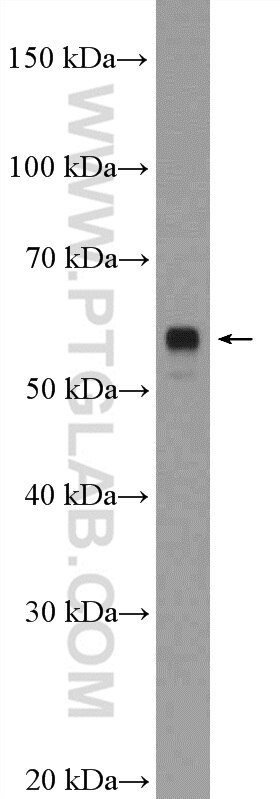Validation Data Gallery
Tested Applications
| Positive WB detected in | mouse spinal cord tissue |
Recommended dilution
| Application | Dilution |
|---|---|
| Western Blot (WB) | WB : 1:500-1:1000 |
| It is recommended that this reagent should be titrated in each testing system to obtain optimal results. | |
| Sample-dependent, Check data in validation data gallery. | |
Published Applications
| IP | See 1 publications below |
Product Information
23094-1-AP targets LRRTM2 in WB, IP, ELISA applications and shows reactivity with human, mouse samples.
| Tested Reactivity | human, mouse |
| Cited Reactivity | human |
| Host / Isotype | Rabbit / IgG |
| Class | Polyclonal |
| Type | Antibody |
| Immunogen | LRRTM2 fusion protein Ag19422 相同性解析による交差性が予測される生物種 |
| Full Name | leucine rich repeat transmembrane neuronal 2 |
| Calculated molecular weight | 516 aa, 59 kDa |
| Observed molecular weight | 59 kDa |
| GenBank accession number | BC126408 |
| Gene Symbol | LRRTM2 |
| Gene ID (NCBI) | 26045 |
| RRID | AB_2879209 |
| Conjugate | Unconjugated |
| Form | Liquid |
| Purification Method | Antigen Affinity purified |
| UNIPROT ID | O43300 |
| Storage Buffer | PBS with 0.02% sodium azide and 50% glycerol , pH 7.3 |
| Storage Conditions | Store at -20°C. Stable for one year after shipment. Aliquoting is unnecessary for -20oC storage. |
Background Information
Leucine-rich repeat transmembrane proteins (LRRTMs) are synaptic cell adhesion molecules. LRRTMs are highly localized in the postsynaptic density and play various roles in the formation, maturation, and function of synapses (PMID: 25951919). LRRTM2 acts as a post-synaptic ligand of Neurexins. LRRTM2 regulates excitatory synapse development and function in the vertebrate nervous system (PMID: 20064387).
Protocols
| Product Specific Protocols | |
|---|---|
| WB protocol for LRRTM2 antibody 23094-1-AP | Download protocol |
| Standard Protocols | |
|---|---|
| Click here to view our Standard Protocols |
Publications
| Species | Application | Title |
|---|---|---|
Elife The molecular appearance of native TRPM7 channel complexes identified by high-resolution proteomics |
